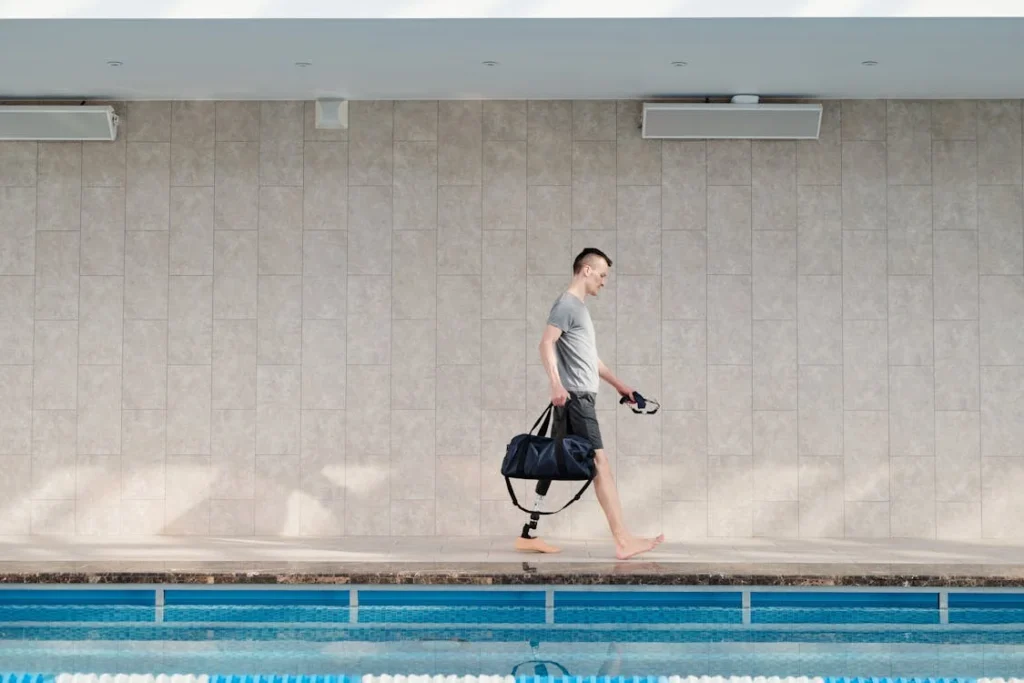Water should never be a barrier to adventure. Whether it’s swimming, kayaking, surfing, or simply enjoying a dip in the pool, people with limb loss deserve prosthetics that let them move freely in the water. The good news? Modern waterproof prosthetics are designed to keep up with your active lifestyle.
Finding the right waterproof prosthetic can feel overwhelming, with so many options available. Some are built for casual swimming, while others can handle extreme water sports. Durability, comfort, and ease of movement are all essential factors to consider.
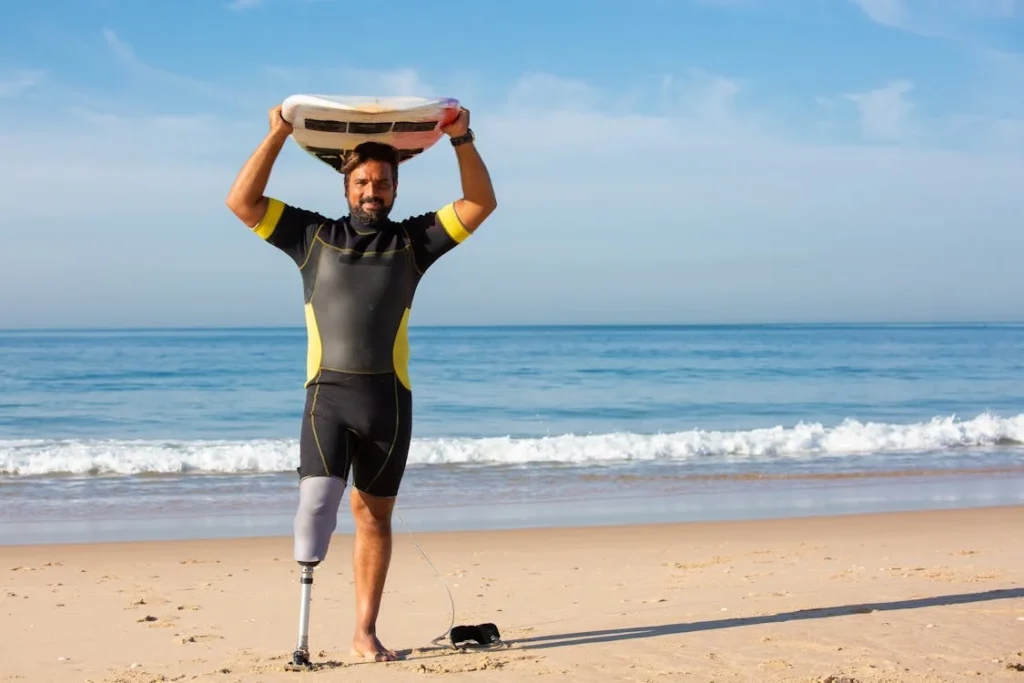
What Makes a Prosthetic Waterproof?
Not all prosthetics are designed to handle water. A standard prosthetic limb, especially one with electronic components or traditional materials, can get damaged if exposed to moisture.
That’s why waterproof prosthetics are specifically engineered to resist water damage while maintaining full functionality.
Materials That Withstand Water
Waterproof prosthetics are made from materials that do not absorb water or degrade over time. High-quality plastics, carbon fiber, stainless steel, and specialized rubber coatings are commonly used.
These materials prevent rust, corrosion, and swelling that could compromise the prosthetic’s performance.
Silicone is often a key component in waterproof prosthetic liners. It creates a comfortable, skin-friendly seal that keeps water out. Some advanced prosthetics also use titanium, which is incredibly strong, lightweight, and naturally resistant to water damage.
The combination of these materials ensures that the prosthetic remains functional even when fully submerged.
Sealed and Corrosion-Resistant Components
Waterproof prosthetics are designed with sealed joints and corrosion-resistant screws to prevent water from seeping into sensitive areas.
Any mechanical parts, such as hinges or rotating joints, are built with non-rusting alloys or specialized coatings to maintain smooth movement even after repeated exposure to water.
For prosthetics with electronic elements, manufacturers use waterproof casings and protective seals to safeguard the internal components.
Some high-tech bionic limbs feature specially designed sensors and motors that function even when wet, allowing users to perform precise movements underwater.
Flexibility and Functionality in Water
A good waterproof prosthetic must not only resist water but also provide proper movement and stability. The best designs allow for natural motion, whether swimming, paddling, or walking on wet surfaces.
Some prosthetic feet come with flexible ankle joints that mimic the way a natural foot moves in water, improving balance and agility.
For upper-limb prosthetics, a secure grip is essential. Some waterproof prosthetic hands have textured surfaces or specialized gripping materials that make it easier to hold onto objects, such as paddles or poolside rails.
Others feature detachable components, allowing users to switch between different attachments depending on their activity.
Why a Waterproof Prosthetic Matters
Without a waterproof prosthetic, people with limb loss face major limitations in water-related activities. A non-waterproof limb might need to be removed before entering the water, making movement difficult and reducing independence. This can be frustrating and, in some cases, even unsafe.
A well-designed waterproof prosthetic allows users to enjoy swimming and water sports without worry. Whether it’s playing in the ocean with family, training for a triathlon, or just enjoying a relaxing swim, having the right prosthetic makes all the difference.
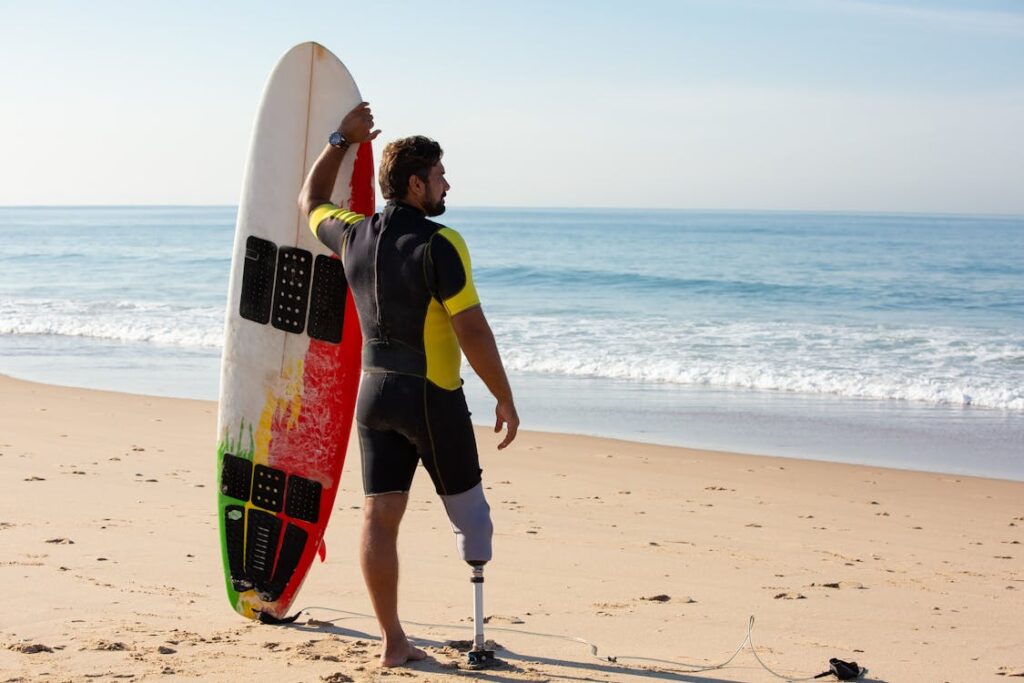
What Makes a Prosthetic Waterproof?
Not all prosthetics are built to handle water. Standard prosthetic devices often have metal components that can rust, electronic parts that can short-circuit, or materials that absorb water and become heavy.
Waterproof prosthetics, on the other hand, are specially designed to resist water damage while maintaining full functionality.
Materials That Resist Water Damage
Waterproof prosthetics are made from materials that do not corrode, absorb moisture, or break down in wet conditions.
High-quality plastics, titanium, stainless steel, and carbon fiber are commonly used to ensure longevity and durability. Silicone is often chosen for liners and sockets because it repels water and stays comfortable against the skin.
One of the biggest challenges for water-resistant prosthetics is sealing off delicate components. If a prosthetic hand has moving parts or electronic sensors, it needs special waterproofing technology.
Some advanced bionic limbs are built with sealed enclosures and protective coatings that prevent water from entering.
Design Features for Swimming and Water Sports
A great waterproof prosthetic is more than just resistant to water; it must also perform well in aquatic environments. The best models are lightweight, allowing for easy movement in the water without unnecessary strain.
For leg prosthetics, non-slip soles help with traction on wet surfaces, whether it’s a pool deck or a surfboard.
Hydrodynamic shaping is another important factor. If a prosthetic is too bulky or has unnecessary resistance, swimming with it will feel unnatural.
Some swimming-specific prosthetic legs come with a streamlined blade-like shape that allows smooth movement through the water. Likewise, waterproof prosthetic hands may have an ergonomic design that allows users to paddle or grip objects underwater.
Different Levels of Water Resistance
There is a difference between water-resistant and fully waterproof prosthetics. Some devices can handle light splashes or rain but should not be fully submerged. Others are designed for complete underwater use, making them ideal for swimming, diving, or high-impact water sports.
Manufacturers often use an IP rating (Ingress Protection) to classify a prosthetic’s resistance to water. A device with an IP67 rating, for example, can withstand brief submersion, while an IP68-rated prosthetic can handle deeper water for longer periods.
Understanding these ratings helps users choose a prosthetic that matches their activity level.
Why Choose a Waterproof Prosthetic?
For active individuals, waterproof prosthetics offer freedom and peace of mind. They eliminate the need to remove the prosthetic before stepping into water, making daily activities easier.
Whether it’s showering, swimming, or engaging in a water-based sport, having the right prosthetic removes limitations and restores independence.
Another key benefit is durability. Even if someone does not swim often, daily exposure to sweat and humidity can wear down a standard prosthetic. A waterproof design ensures the device lasts longer, reducing maintenance and repair costs.
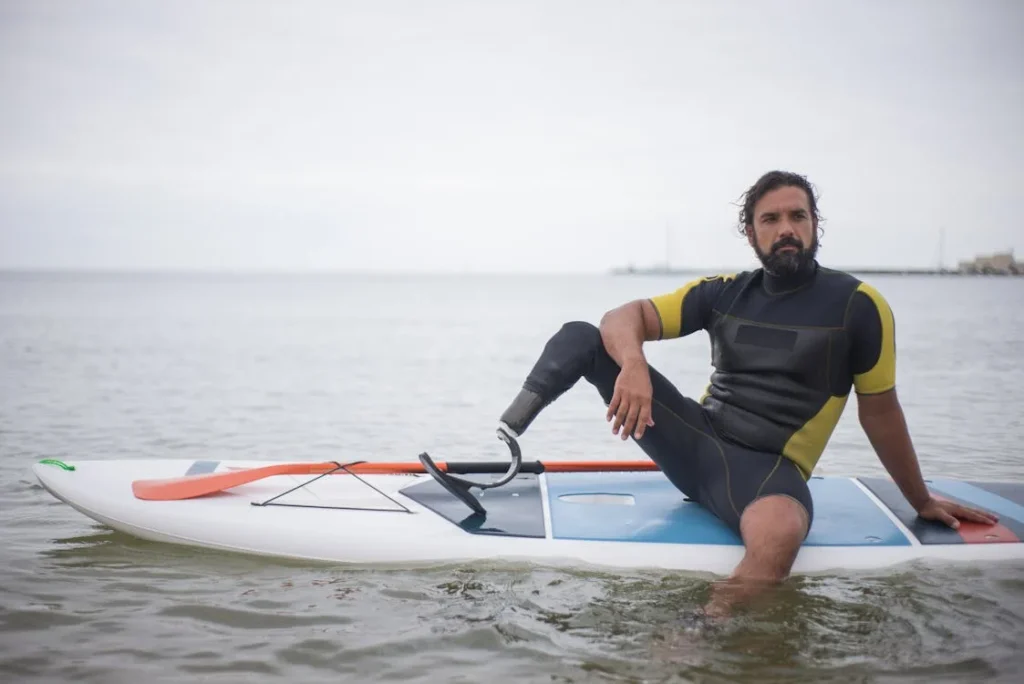
Best Waterproof Prosthetics for Swimming and Water Sports
Waterproof prosthetics have changed the way people with limb loss engage in water activities. From casual swimming to intense water sports, there are specialized designs that allow users to move freely without worry.
Choosing the right prosthetic depends on individual needs, whether it’s for floating in a pool, competing in a triathlon, or catching waves on a surfboard.
Prosthetic Legs for Water Activities
Waterproof prosthetic legs need to be lightweight, strong, and resistant to corrosion. Many models are made from titanium or carbon fiber, materials that provide durability without adding unnecessary weight.
Some prosthetic legs are designed with an open-frame structure, preventing water from getting trapped inside. Others have a quick-drying socket to prevent discomfort after getting out of the water.
A common choice for swimming is the hydrodynamic prosthetic leg, which is shaped to minimize drag. These legs allow for smooth kicking motions, making them ideal for swimming laps or participating in water-based sports.
Some models even feature interchangeable feet, allowing users to switch between a standard foot for walking and a specialized fin-like extension for swimming.
For those who enjoy surfing, kiteboarding, or paddleboarding, grip and flexibility are essential. Many water sports prosthetic legs come with non-slip soles that provide traction on wet surfaces.
Adjustable ankle joints are also useful, as they allow users to maintain balance on unstable terrain. Some designs are even compatible with water shoes, offering extra support and protection.
Prosthetic Arms and Hands for Swimming
Swimming and water sports require a different approach for upper-limb prosthetics. Unlike leg prosthetics, which focus on stability and propulsion, waterproof prosthetic arms and hands are designed for flexibility and ease of movement.
One of the best options for swimmers is a swimming prosthetic hand, which is shaped to create resistance against the water, similar to a swim paddle.
This design helps users generate forward motion, making swimming more efficient. Some hands are designed to lock into a specific shape, while others have flexible fingers that adjust to different strokes.
For individuals who engage in sports like kayaking or rowing, grip strength is crucial. Waterproof prosthetic hands with locking mechanisms allow users to hold onto paddles securely, preventing them from slipping during intense activity.
Some models have quick-release functions, allowing for easy detachment in case of an emergency.
Bionic Limbs and Water Resistance
Advanced bionic limbs with electronic components typically require extra protection from water exposure. While many modern bionic hands and legs come with some level of water resistance, fully submersible models are less common.
Some manufacturers have developed high-tech bionic limbs with sealed electronics and waterproof coatings, allowing users to wear them in wet environments without damage.
For those who rely on bionic technology but still want to enjoy water activities, one solution is to use protective covers. These covers create a watertight seal around the prosthetic, preventing moisture from reaching delicate components.
While this is not the same as having a fully waterproof bionic limb, it provides an extra layer of security for those who want to enjoy the water without risking damage to their device.
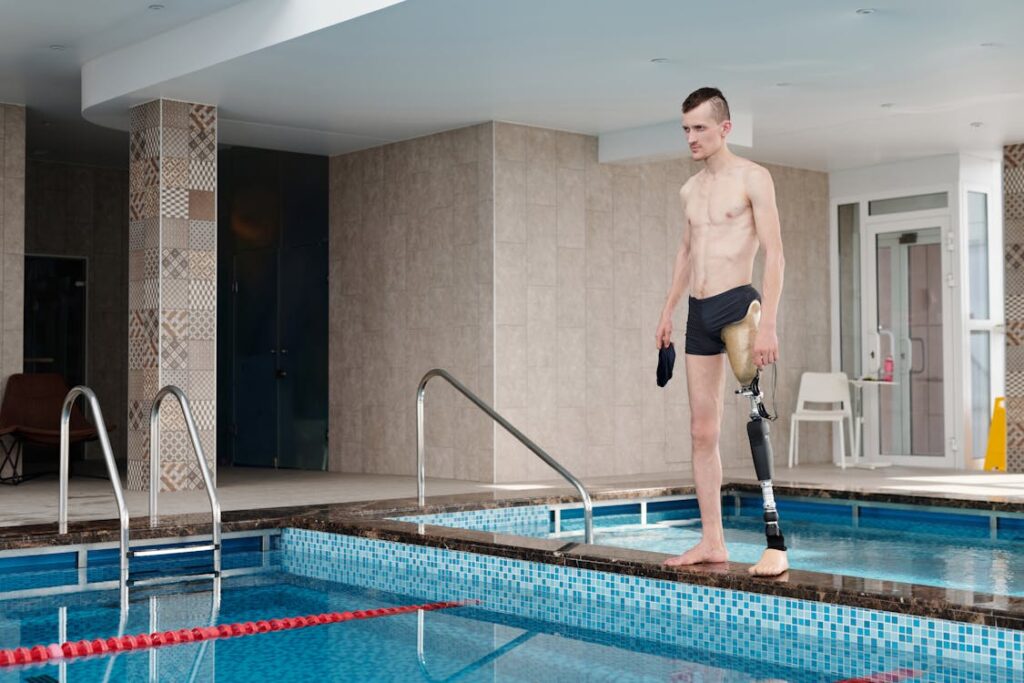
How to Choose the Right Waterproof Prosthetic for You
Selecting a waterproof prosthetic depends on several factors, including activity level, comfort, and durability.
Not all prosthetics are built the same, and what works for casual swimming may not be suitable for extreme water sports. Understanding your specific needs is key to making the right choice.
Assessing Your Activity Level
The first step in choosing a waterproof prosthetic is determining how often and in what way you plan to use it in water. If you’re someone who enjoys occasional swimming or simply wants a device that won’t be damaged by water exposure, a basic waterproof design might be enough.
For those who regularly participate in water sports like surfing, kayaking, or scuba diving, a more specialized prosthetic is necessary.
High-impact activities require prosthetics with secure attachments, strong grip, and durable materials that can withstand saltwater, chlorine, and constant movement.
If you’re an athlete or plan to compete, a prosthetic with a hydrodynamic shape will allow for better performance in the water.
Comfort and Fit Matter
A well-fitting prosthetic makes all the difference when it comes to water activities. Water-resistant materials are great, but if the prosthetic isn’t comfortable, it won’t be practical for long-term use. Silicone liners and well-sealed sockets help keep water out and prevent irritation.
One issue many users face is water getting trapped inside the prosthetic. This can cause discomfort and affect mobility.
Some waterproof prosthetics are designed with built-in drainage systems to prevent water buildup. Quick-drying materials also help keep the prosthetic comfortable even after leaving the water.
Ease of Maintenance
Waterproof prosthetics may be designed to handle moisture, but they still require proper care. Exposure to saltwater, chlorine, or sand can wear down certain components over time. Choosing a prosthetic that is easy to clean and maintain will ensure longevity.
Some prosthetic models are fully modular, meaning that individual parts can be replaced if they become worn or damaged. This is particularly useful for people who engage in high-impact water sports, as certain elements may need regular maintenance.
Checking with a prosthetist about available spare parts and repair services is always a good idea before making a purchase.
Cost and Accessibility
High-quality waterproof prosthetics can be an investment, but they provide long-term benefits in terms of durability and usability. While imported waterproof prosthetics can be expensive, there are cost-effective solutions available in India.
Locally manufactured waterproof prosthetics, such as those provided by Robobionics, offer a balance of affordability, quality, and easy servicing.
Choosing a prosthetic that comes with local support is a major advantage. Instead of waiting for expensive replacements from overseas, users can access repairs and modifications quickly.
This ensures uninterrupted access to water-based activities without the stress of long downtimes or high costs.
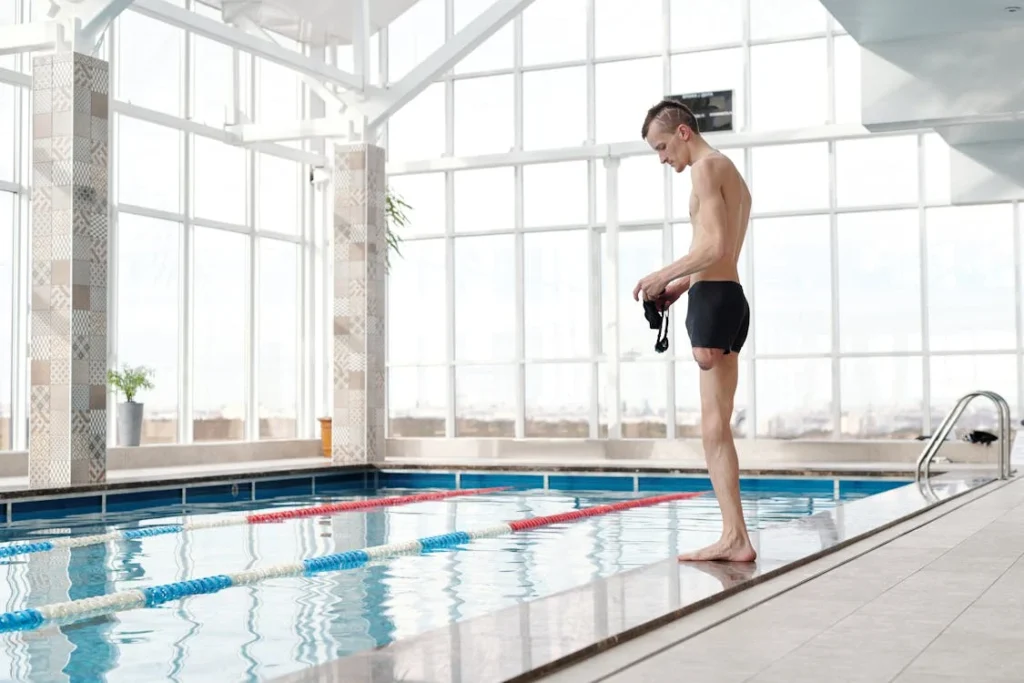
Caring for Your Waterproof Prosthetic
Even though waterproof prosthetics are designed to handle wet environments, proper care is essential to maintain their longevity and performance.
Exposure to chlorine, saltwater, and sand can affect different components over time. Taking a few simple steps can help keep your prosthetic in the best condition for years to come.
Rinsing After Every Use
After swimming in the ocean, a pool, or a lake, it’s important to rinse your prosthetic thoroughly with fresh water. Salt and chlorine can cause long-term damage to materials, even those designed to resist corrosion.
A quick rinse helps remove any lingering chemicals or debris that could weaken the prosthetic over time.
For leg prosthetics, paying extra attention to the joints and attachment areas is crucial. Sand and small particles can get trapped in moving parts, causing stiffness or discomfort. Running water through these areas and gently shaking out excess moisture prevents buildup.
Drying and Storage
Although waterproof prosthetics are made to handle moisture, storing them properly is just as important as cleaning them. Drying the prosthetic thoroughly after use helps prevent mold and bacterial growth.
Using a soft, absorbent cloth to wipe down the device and leaving it to air dry in a well-ventilated area is recommended.
Storing the prosthetic in a cool, dry place also extends its lifespan. Leaving it in direct sunlight or high heat for prolonged periods can weaken certain materials, affecting durability.
If the prosthetic has silicone liners or rubber seals, checking for wear and tear regularly helps prevent potential leaks or discomfort.
Checking for Wear and Tear
Even the most durable prosthetic needs occasional maintenance. Regularly inspecting your prosthetic for signs of wear can prevent small issues from turning into major problems.
Checking for cracks, loose components, or stiffness in joints ensures that your prosthetic remains safe and functional.
Waterproof prosthetics with mechanical joints or moving parts may require lubrication to keep them operating smoothly. If you notice unusual resistance or difficulty in movement, consulting with a prosthetist for adjustments can help restore functionality.
Professional Maintenance and Repairs
If a waterproof prosthetic starts to show signs of damage, getting it checked by a professional is the best course of action. Some issues, like minor surface wear, can be fixed easily, while more significant damage may require part replacements.
Choosing a prosthetic from a provider with accessible servicing options can make repairs easier. Robobionics offers local repair and maintenance services, ensuring quick solutions without the hassle of international shipping or long wait times.
Regular servicing keeps your prosthetic in top condition and ensures you can continue enjoying water activities without interruption.

Breaking Barriers: The Freedom of Waterproof Prosthetics
Waterproof prosthetics are more than just specialized devices—they represent freedom. The ability to swim, surf, dive, or simply walk along the shoreline without limitations is life-changing for individuals with limb loss.
Advances in technology and design have made it possible for prosthetic users to enjoy water activities just like anyone else.
Regaining Confidence in the Water
For many people with limb loss, the fear of damaging their prosthetic or struggling with mobility in water can be discouraging. Traditional prosthetics are often heavy, prone to water damage, and difficult to use in aquatic settings.
Waterproof prosthetics remove these concerns, giving users the confidence to move freely without worry.
Swimming can be an incredible form of exercise, rehabilitation, and recreation. It strengthens muscles, improves cardiovascular health, and reduces strain on joints.
For amputees, it can also serve as a powerful way to regain control over their bodies. With a well-fitted waterproof prosthetic, swimming becomes natural and enjoyable rather than challenging.
Expanding Sports and Recreation Opportunities
The development of high-performance waterproof prosthetics has opened doors for amputees in sports and outdoor adventures. Adaptive surfing competitions, para-swimming events, and kayaking expeditions are now more accessible than ever.
With the right prosthetic, athletes can compete at the highest level, while casual users can enjoy their favorite activities without limitations.
Innovations in prosthetic technology have even enabled deep-sea divers with limb loss to explore the underwater world.
Specialized prosthetic designs provide the necessary flexibility, grip, and durability to handle high-pressure environments. These breakthroughs are not just about function—they redefine what is possible.
Making Everyday Life Easier
Beyond sports and recreation, waterproof prosthetics improve everyday life. Simple activities like showering, walking in the rain, or visiting the beach are no longer a challenge.
Users don’t have to remove their prosthetics or switch to a backup device when encountering water. This convenience saves time and effort, making daily routines smoother and stress-free.
For parents with young children, waterproof prosthetics can be especially valuable. Playing in the pool, helping kids at bath time, or enjoying a family vacation at the beach becomes effortless. No more worrying about damaging the prosthetic or missing out on special moments.
A Future Without Limits
As prosthetic technology continues to evolve, the gap between artificial limbs and natural movement is shrinking. More advanced materials, improved waterproofing techniques, and adaptive designs are making prosthetics not just functional but truly empowering.
At Robobionics, we are committed to making high-quality, affordable prosthetics that meet the needs of real users. Whether you’re an athlete, a swimmer, or someone who simply wants to live life without restrictions, we believe that nothing should hold you back.
Conclusion
Waterproof prosthetics have revolutionized mobility, giving individuals with limb loss the freedom to swim, surf, dive, and enjoy water activities without limitations. Whether for casual swimming, high-performance sports, or everyday convenience, the right waterproof prosthetic can restore confidence and independence.
Choosing a prosthetic that fits your lifestyle is key. Factors like durability, comfort, and ease of maintenance make all the difference. With advances in materials and design, today’s waterproof prosthetics are lighter, stronger, and more adaptable than ever before.
At Robobionics, we believe that no one should have to compromise on their passions. Our innovative, high-quality prosthetic solutions are designed to keep up with your active life while offering local support and affordability. Whether you’re looking for a swimming-friendly prosthetic hand or a high-performance leg for water sports, we’re here to help.
Book a free consultation today and take the first step toward a future where water is no longer a barrier, but an opportunity for adventure!



